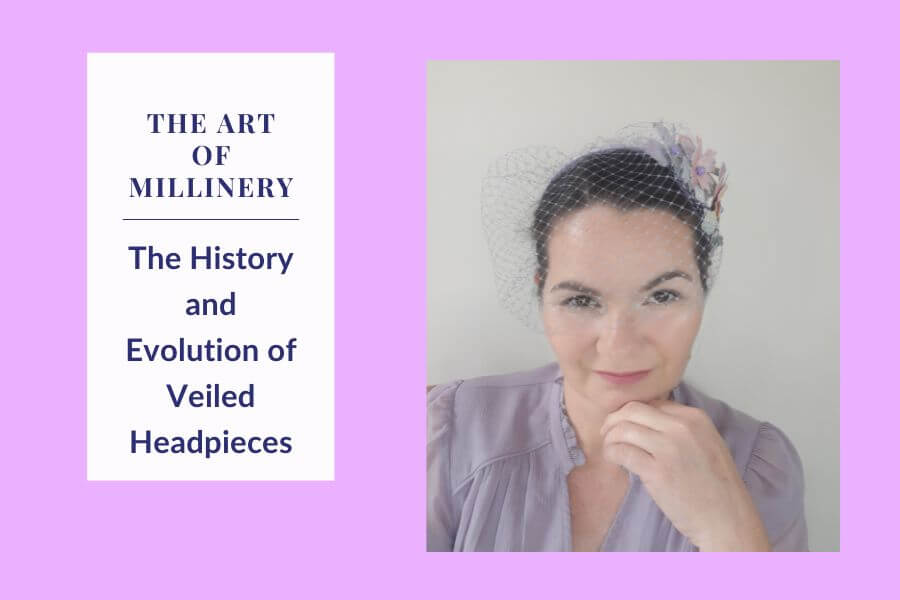
The Art of Millinery: The History and Evolution of Veiled Headpieces
Millinery is more than just hats—it is an art form that has shaped fashion history for centuries. One of the most intriguing elements of millinery is veiling, a feature that has been used to symbolize modesty, mystery, and allure. From historical traditions to high fashion, veils have evolved from functional accessories to powerful statements of personal style. This post explores the history and significance of veiling, its role in bridal fashion, and how modern milliners continue to reinvent it.
The Origins of Veiling: Modesty, Mystery, and Social Status
The practice of wearing veils dates back thousands of years. In ancient Egypt, Greece, and Rome, veils were used to indicate status and modesty. Byzantine women of high rank wore veils as a sign of their privilege, while medieval European brides adopted veiling to represent purity and protection from evil spirits. During the Renaissance, veils became more decorative, often made from fine lace or silk to indicate wealth and refinement.
In the Victorian era, mourning veils emerged as a symbol of grief, with widows wearing long black veils as a sign of respect for the deceased. These veils not only shielded their emotions from public view but also became a key element of mourning fashion. Meanwhile, in the early 20th century, veiled hats became a fashionable staple for women, adding an air of sophistication and intrigue.
Veiling in Funerals: A Continuing Tradition
Though veils at funerals are less common today, they continue to be worn in certain cultures and formal settings as a sign of respect and grief. The tradition of veiling in mourning has deep historical and cultural roots, symbolizing solemnity, modesty, and a visual expression of sorrow. While modern customs have relaxed, veiling remains a meaningful gesture for those who choose to observe it.
In many religious and traditional funerals, veils or head coverings play an important role. Within Catholic and Orthodox Christian traditions, black veils or lace mantillas have been worn by grieving women as a mark of reverence. Similarly, in Islamic customs, women may wear a hijab or additional covering as part of mourning practices. These traditions emphasize the idea of humility and respect when paying tribute to the deceased.
The use of veils at funerals is also evident in royal and high-society ceremonies, where black veiling has historically been a symbol of mourning and decorum. Members of the British royal family, for example, have been known to wear black veils at state funerals, including Queen Elizabeth II at the funeral of King George VI. Such customs underscore the gravity of the occasion and align with long-standing aristocratic mourning attire.
Beyond tradition, some individuals opt for veiled headpieces as a personal or fashion choice to subtly honour funeral etiquette. A delicate netted veil, a small hat with a mourning veil, or a discreet black head covering can serve as a nod to formality and tradition without adhering to rigid expectations. This choice allows for a blend of historical elegance and modern mourning customs, ensuring a dignified and respectful presentation.
While veiling is no longer a universal expectation at funerals, it remains a powerful symbol of grief, respect, and dignity. Whether embraced for cultural, religious, or personal reasons, the practice endures as a timeless expression of mourning in both contemporary and traditional settings.
Veiling in Bridal Fashion: Innocence or Seduction?
One of the most enduring uses of veiling has been in bridal fashion. Traditionally, wedding veils symbolized innocence and purity, with the act of lifting the veil serving as a gesture of unveiling the bride to her partner. The length and style of veils often carried cultural significance, with cathedral veils exuding grandeur and blusher veils adding a sense of delicate modesty.
However, veils have also been associated with seduction and mystery. Shorter veils, such as the birdcage veil, became popular in the 1940s and 1950s, framing the face while offering a playful, flirtatious appeal. Modern brides have reinterpreted veiling in bold ways, incorporating lace, embellishments, and dramatic silhouettes to reflect their personality rather than conforming to tradition.
Veiling in High Fashion & Avant-Garde Millinery
Beyond bridal wear, veiling has made an indelible mark on high fashion. Designers such as Alexander McQueen, Christian Dior, and Philip Treacy have used veils to evoke mystery, power, and artistic expression. Whether cascading over a wide-brimmed hat or delicately draping over the face, veils add depth to couture fashion, transforming headwear into wearable art.
Runway shows frequently feature veiling as a dramatic styling element, incorporating sheer mesh, netting, and intricate lace to create otherworldly effects. Celebrities and fashion icons have embraced veiled headpieces on red carpets, proving that veiling remains an enduring trend that transcends time and tradition.
Contemporary Trends: Reinventing the Veil
Today, veiling is no longer confined to tradition; it has evolved into a versatile accessory that can be styled in countless ways. Milliners continue to push the boundaries of design, experimenting with materials, colours, and structures to create bold and innovative alternatives.
One striking development is the use of colourful and embellished veils, which move beyond the classic white to incorporate vivid hues, intricate beading, and artistic embroidery. These veils add a unique, personalized touch, allowing wearers to make a statement while still embracing the elegance of traditional veiling.
Another growing trend is eco-friendly veiling, as sustainable and ethical materials gain traction in modern millinery. Brides and fashion enthusiasts now have access to veils made from organic, cruelty-free fabrics, such as plant-based textiles or upcycled lace, aligning their style choices with environmental consciousness.
Contemporary millinery also embraces unconventional shapes and cuts, reimagining veils with geometric patterns, asymmetrical drapes, and unexpected structural elements. These modern interpretations challenge conventional aesthetics, offering fresh and artistic expressions of veiling that cater to bold, fashion-forward individuals.
As veiling continues to evolve, it remains a timeless yet dynamic element of millinery, seamlessly blending tradition with innovation.
Conclusion
Veiled headpieces have evolved from symbols of modesty to expressions of confidence, romance, and individuality. Whether worn in a traditional wedding, a high-fashion event, or as a personal style statement, veils continue to captivate with their duality—hiding while revealing, softening while strengthening. As milliners and designers embrace innovation, veiling remains an enduring and transformative element in the art of millinery.
Would you wear a veiled headpiece? Share your thoughts in the comments!
